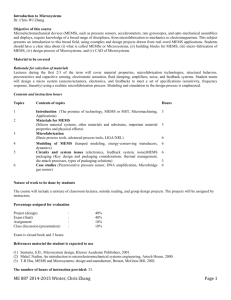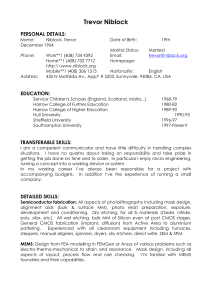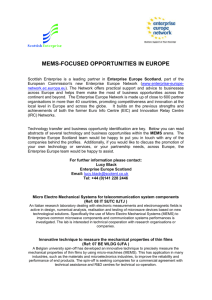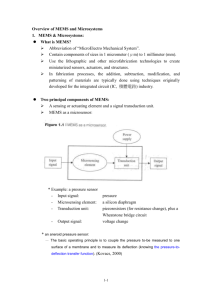What is MEMS Technology
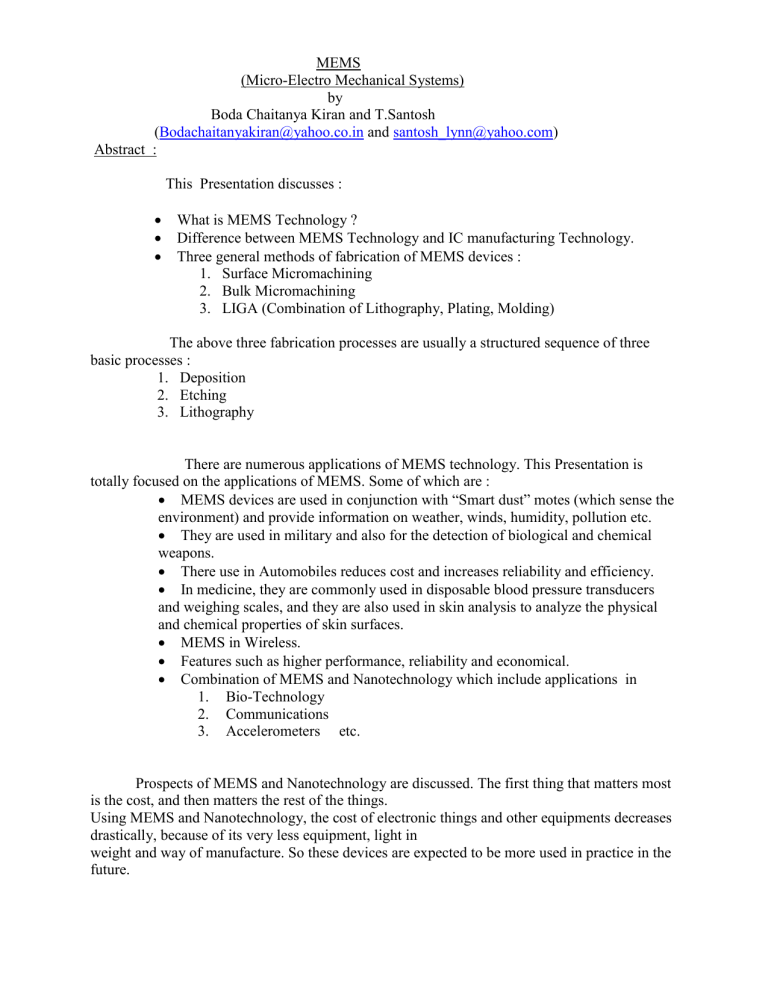
MEMS
(Micro-Electro Mechanical Systems)
by
Boda Chaitanya Kiran and T.Santosh
( Bodachaitanyakiran@yahoo.co.in
and santosh_lynn@yahoo.com
)
Abstract :
This Presentation discusses :
What is MEMS Technology ?
Difference between MEMS Technology and IC manufacturing Technology.
Three general methods of fabrication of MEMS devices :
1.
Surface Micromachining
2.
Bulk Micromachining
3.
LIGA (Combination of Lithography, Plating, Molding)
The above three fabrication processes are usually a structured sequence of three basic processes :
1.
Deposition
2.
Etching
3.
Lithography
There are numerous applications of MEMS technology. This Presentation is totally focused on the applications of MEMS. Some of which are :
MEMS devices are used in conjunction with “Smart dust” motes (which sense the environment) and provide information on weather, winds, humidity, pollution etc.
They are used in military and also for the detection of biological and chemical weapons.
There use in Automobiles reduces cost and increases reliability and efficiency.
In medicine, they are commonly used in disposable blood pressure transducers and weighing scales, and they are also used in skin analysis to analyze the physical and chemical properties of skin surfaces.
MEMS in Wireless.
Features such as higher performance, reliability and economical.
Combination of MEMS and Nanotechnology which include applications in
1.
Bio-Technology
2.
Communications
3.
Accelerometers etc.
Prospects of MEMS and Nanotechnology are discussed. The first thing that matters most is the cost, and then matters the rest of the things.
Using MEMS and Nanotechnology, the cost of electronic things and other equipments decreases drastically, because of its very less equipment, light in weight and way of manufacture. So these devices are expected to be more used in practice in the future.
What is MEMS Technology?
Micro-Electro-Mechanical Systems (MEMS) is the integration of mechanical elements, sensors, actuators, and electronics on a common silicon substrate through microfabrication technology. While the electronics are fabricated using integrated circuit
(IC) process sequences (e.g., CMOS, Bipolar, or BICMOS processes), the micromechanical components are fabricated using compatible "micromachining" processes that selectively etch away parts of the silicon wafer or add new structural layers to form the mechanical and electromechanical devices.
MEMS promises to revolutionize nearly every product category by bringing together silicon-based microelectronics with micromachining technology, making possible the realization of complete systems-on-a-chip. MEMS is an enabling technology allowing the development of smart products, augmenting the computational ability of microelectronics with the perception and control capabilities of microsensors and microactuators and expanding the space of possible designs and applications.
Microelectronic integrated circuits can be thought of as the "brains" of a system and
MEMS augments this decision-making capability with "eyes" and "arms", to allow microsystems to sense and control the environment. Sensors gather information from the environment through measuring mechanical, thermal, biological, chemical, optical, and magnetic phenomena. The electronics then process the information derived from the sensors and through some decision making capability direct the actuators to respond by moving, positioning, regulating, pumping, and filtering, thereby controlling the environment for some desired outcome or purpose. Because MEMS devices are manufactured using batch fabrication techniques similar to those used for integrated circuits, unprecedented levels of functionality, reliability, and sophistication can be placed on a small silicon chip at a relatively low cost.
MEMS Technology
MEMS and ICs: two of a kind
Making the transition: from prototype to manufacture
Manufacturing methods
Surface micromachining
Bulk micromachining
LIGA
Manufacturing steps
Deposition
Etching
Lithography
MEMS and ICs: two of a kind
MEMS microstructures are manufactured in batch methodologies similar to computer microchips. The photolithographic techniques that mass-produce millions of complex microchips can also be used simultaneously to develop and produce mechanical sensors and actuators integrated with electronic circuitry. Most MEMS devices are built on wafers of silicon, adopting micromachining technologies from integrated circuit (IC) manufacturing and batch fabrication techniques.
Like ICs, the structures are developed in thin films of materials. The processes are based on depositing thin films of metal or crystalline material on a substrate, applying patterned masks by photolithographic imaging, and then etching the films to the mask.
In effect, a sacrificial layer is introduced
– a material which keeps other layers separated as the structure is being built up but is dissolved in the very last step allowing selective parts of the structure free to move.
This use of established “batch” processing of MEMS devices, similar to volume IC manufacturing processes, eliminates many of the cost barriers that inhibit large scale production using other less proven technologies. Although MEMS fabrication may consist of a multi-step process, the simultaneous manufacture of large numbers of these devices on a single wafer greatly reduces the overall per unit cost.
Making the transition: from prototype to manufacture
Prototyping is integral to the process, however. An initial device is produced that can be characterized, measured, and optimized for performance and high volume manufacture.
A key challenge can be the leap from prototype to high volume manufacture
– a transition that sometimes requires considerable modifications. This requires the availability of broad-based design and process expertise (not just application experience), as well as appropriate software tools that can automatically provide process customization. CAD tools are crucial to a cost and time-effective process.
Previously developed internally, there are now several commercially available CAD packages that guide engineering teams through component design, system design, and analysis.
It's important to note that MEMS manufacturing technology is not a uniform science but rather a combination of design techniques and knowledge of materials, process, and applications. Processes may vary considerably. For example, the techniques used for wireless may not work at all for the development and production of optical communications devices. Further, although MEMS and IC manufacturing is based on photolithographic etching, in many cases the processes and/or materials may not be compatible. It's interesting to note that gold, which is required in the manufacture of optical MEMS, will contaminate an IC batch.
There are three general approaches to the fabrication of MEMS: surface micromachining, bulk micromachining, and LIGA (lithography, plating, molding).
Surface micromachining is a process based on the building up of material layers selectively remaining or removed by continued processing. The bulk of the substrate remains untouched.
In bulk micromachining, large portions of the substrate are removed to form the desired structure. Structures with greater heights can be formed because thicker substrates can be used. The bulk micromachining process is a key fabrication method used for MEMSbased photonic switching in the high-growth optical and wireless markets.
LIGA processes combine IC lithography and electroplating and molding to obtain depth.
Patterns are created in a substrate and then electroplated to create 3D molds. These molds can be used as the final product, or various materials can be injected into them.
This process has two advantages. Materials other than silicon can be used (e.g. metal, plastic) and devices with very high aspect ratios can be built.
The fabrication process is usually a structured sequence of THREE BASIC
PROCESSES:
1. Deposition
Deposition is a key building block in that it is the ability to deposit thin films of material
(for subsequent local etching). MEMS deposition technology is classified in two groups:
Depositions resulting from chemical reactions: chemical vapor deposition, electrodeposition, epitaxy, and themal oxidation. These processes exploit the creation of solid materials directly from chemical reactions in gas and/or liquid compositions or with the substrate material. The solid material is usually not the only product formed by the reaction. Byproducts can include gases, liquids and even other solids.
Depositions resulting from physical reaction: physical vapor deposition, casting. The material deposited is physically moved on to the substrate (a chemical byproduct is not created).
2. Etching
In order to form a functional MEMS structure on a substrate it is necessary to etch the thin films previously deposited and/or the substrate itself. In general, there are two classes of etching processes:
Wet etchng: the material is dissolved when immersed in a chemical solution
Dry etching: the material is sputtered or dissolved using reactive ions or a vapor phase etchant.
3. Lithography
Lithography in the MEMS context is typically the transfer of a pattern to a photosensitive material by selective exposure to a radiation source such as light. When a photosensitive material is selectively exposed to radiation (e.g. by masking some of the radiation), the radiation pattern on the material is transferred to the material exposed
(the properties of the exposed and unexposed regions differ).
MEMS Applications
Automotive: the first high volume application
MEMS come of age
Imagine dust, floating in the air, gathering information on the weather, winds, humidity and pollution – all in a tiny cubic millimeter package. This is the “smart dust” scientists at
UC Berkeley are developing in the laboratory today. Thousands or millions of these dust motes will sense the environment and communicate simultaneously using MEMS devices. Other applications under development range from such medical uses as hospital rooms that track patients and their medications and treatments, to the use of tiny surgical “scrapers” injected into arteries to clean out plaque, to military reconnaissance, to the detection of biological and chemical weapons.
Automotive: the first high volume application
After spending about 25 years in the lab, however, it was the automotive industry which first commercially embraced MEMS devices in the '90's as airbag accelerometers, recognizing the benefits of MEMS devices' small size, relative low cost and high degree of sensitivity.
Early airbags required the installation of several bulky accelerometers made of discrete components mounted in the front of the car, with separate electronics near the airbag
(at a cost of over $50). Today, because of MEMS, the accelerometer and electronics are integrated on a single chip at a cost of under $10. The small size (about the dimensions of a sugar cube) provides a quicker response to rapid deceleration. And because of the very low cost, manufacturers are adding side impact airbags as well.
The sensitivity of MEMS devices is also leading to improvements where size and weight of passengers will be calculated so the airbag response will be appropriate for each passenger.
There are many other automotive applications for MEMS either in use now or coming soon, including fuel pressure sensors, air flow sensors, tire pressure sensors with automatic builtin tire pumps, “smart” sensors for collision avoidance and skid detection,
“smart” suspension for sport utility vehicles to reduce rollover risk, automatic seatbelt restraint and door locking, vehicle security, headlight leveling, and navigation.
MEMS come of age
Another wide deployment of MEMS is their use as micronozzles that direct the ink in inkjet printers. They are also used to create miniature robots (micro-robots) as well as micro-tweezers, and are used in video projection chips with a million moveable mirrors.
MEMS have been rigorously tested in harsh environments for defense and aerospace where they are used as navigational gyroscopes, sensors for border control and environmental monitoring, and munitions guidance. In medicine they are commonly used in disposable blood pressure transducers and weighing scales.
Out of these practical experiences have grown a raft of other applications which are quickly approaching everyday use. For example, engineers are utilizing the ability of
MEMS devices to collectively assemble informati on and applying it to “smart roads.”
Smart roads would be covered with millions of MEMS sensors. The sensors would act as a blanket of information, gathering and transmitting data about road conditions to people charged with maintaining them. Problems with roadways would be detected and repaired before they became serious. These smart roads could also send information to cars equipped with Global Positioning Devices, informing the on-board computer of road hazards, accidents, and traffic. Another safety application includes the detection of black ice on roadways and the development of windshields with automatic glare resistance.
Other arenas into which MEMS are moving include package shipping, where MEMS shock sensors would rest inside packages to monitor time and any type of damage that may occur while the package is in transit. One commercial application that is coming to market within months is a compact skin analysis unit for medical and consumer use, including department store cosmetics counters and pharmacies. This tool will contain
small sensor-based units to analyze the physical and chemical properties of skin surfaces.
An additional and significant growth area for MEMS today is in telecommunications where the technology is being used for wireless applications as well as in optical networks.
MEMS in Wireless
More functionality but more components
Towards a single-chip RF circuit
Higher performance, reliability, lower cost per unit
The wireless industry is growing and changing rapidly. With the advent of new technology combined with the demand for more bandwidth and increased mobility, wireless applications are spreading to new markets – from radar-equipped passenger vehicles to biomedical devices that, when injected or inserted, send data to a receiver outside the body. As the wireless device market grows, so will the semiconductor products that support it.
More functionality but more components
Wireless system manufacturers compete to add more functionality to equipment. A 3G
“smart” phone, PDA, or base station, for example, will require the functionality of as many as five radios – for TDMA, CDMA, 3G, Bluetooth and GSM operation. A huge increase in component count is required to accomplish this demand. And other wireless verticals are facing the same challenge. Yet while the market demands the new functions, it also expects smaller form factors, lower costs and reduced power consumption.
Towards a single-chip RF circuit
A solution with tighter and cost-effective integration is clearly needed. Integrating MEMS devices directly on the RF chip itself or within a module, can enable the replacement of numerous discrete components while offering such competitive benefits as higher performance and reliability, smaller form factors, and lower cost as a result of highvolume, high-yield IC-compatible processes.
Discrete passives such as RF-switches, varicaps, high-Q resonators and filters have been identified as components that can be replaced by RF-MEMS counterparts.
For radio frequency, or RF, app lications there is the innovative “above-IC” (AIC) technology that enables the placement of RF MEMS devices directly on top of the IC by using a thick copper technology compatible with CMOS, BiCMOS and gallium arsenide processes.
The industry is just beginning to see the benefits of such integrated devices. And, over time, integration of RF-MEMS devices may be the means to replace all passive RF chips with on-chip devices, achieving the long-awaited single-chip RF solution. Current technology and process limitations will prevent placement of all passive components with on-chip MEMS components. But placing even some components on-chip offers
significant space and cost savings, allowing smaller form factors, benefiting cell phones for example, or added functionality such as Internet connectivity.
Higher performance, reliability, lower cost per unit
Higher speed and reliability are other likely improvements. Having components on-chip means they are more tightly integrated and can communicate faster with the IC. And because lighter MEMS components are really part of the chip and not attached to the board, they are less likely to be damaged if a phone is dropped.
Not the least of benefits is cost savings. A circuit board with as many as 800 components may cost close to $30 to manufacture. Using MEMS may eliminate as many as 200 discrete parts, saving approximately $8 per unit.
MEMS and Nanotechnology Applications
There are numerous possible applications for MEMS and Nanotechnology. As a breakthrough technology, allowing unparalleled synergy between previously unrelated fields such as biology and microelectronics, many new MEMS and Nanotechnology applications will emerge, expanding beyond that which is currently identified or known.
Here are a few applications of current interest:
Biotechnology
MEMS and Nanotechnology is enabling new discoveries in science and engineering such as the Polymerase Chain Reaction (PCR) microsystems for DNA amplification and identification, micromachined Scanning Tunneling Microscopes (STMs), biochips for detection of hazardous chemical and biological agents, and microsystems for highthroughput drug screening and selection.
Communications
High frequency circuits will benefit considerably from the advent of the RF-MEMS technology. Electrical components such as inductors and tunable capacitors can be improved significantly compared to their integrated counterparts if they are made using
MEMS and Nanotechnology. With the integration of such components, the performance of communication circuits will improve, while the total circuit area, power consumption and cost will be reduced. In addition, the mechanical switch, as developed by several research groups, is a key component with huge potential in various microwave circuits.
The demonstrated samples of mechanical switches have quality factors much higher than anything previously available.
Reliability and packaging of RF-MEMS components seem to be the two critical issues that need to be solved before they receive wider acceptance by the market.
Accelerometers
MEMS accelerometers are quickly replacing conventional accelerometers for crash airbag deployment systems in automobiles. The conventional approach uses several bulky
accelerometers made of discrete components mounted in the front of the car with separate electronics near the air-bag; this approach costs over $50 per automobile.
MEMS and Nanotechnology has made it possible to integrate the accelerometer and electronics onto a single silicon chip at a cost between $5 to $10. These MEMS accelerometers are much smaller, more functional, lighter, more reliable, and are produced for a fraction of the cost of the conventional macroscale accelerometer elements
Fabricating MEMS and Nanotechnology
MEMS and Nano devices are extremely small -- for example, MEMS and
Nanotechnology has made possible electrically-driven motors smaller than the diameter of a human hair (right) -- but MEMS and Nanotechnology is not primarily about size.
MEMS and Nanotechnology is also not about making things out of silicon, even though silicon possesses excellent materials properties, which make it an attractive choice for many high-performance mechanical applications; for example, the strength-to-weight ratio for silicon is higher than many other engineering materials which allows very highbandwidth mechanical devices to be realized.
Instead, the deep insight of MEMS and Nano is as a new manufacturing technology, a way of making complex electromechanical systems using batch fabrication techniques similar to those used for integrated circuits, and uniting these electromechanical elements together with electronics.
Advantages of MEMS and Nano Manufacturing
First, MEMS and Nanotechnology are extremely diverse technologies that could significantly affect every category of commercial and military product. MEMS and
Nanotechnology are already used for tasks ranging from in-dwelling blood pressure monitoring to active suspension systems for automobiles. The nature of MEMS and
Nanotechnology and its diversity of useful applications make it potentially a far more pervasive technology than even integrated circuit microchips.
Second, MEMS and Nanotechnology blurs the distinction between complex mechanical systems and integrated circuit electronics. Historically, sensors and actuators are the most costly and unreliable part of a macroscale sensor-actuator-electronics system.
MEMS and Nanotechnology allows these complex electromechanical systems to be manufactured using batch fabrication techniques, decreasing the cost and increasing the reliability of the sensors and actuators to equal those of integrated circuits. Yet, even though the performance of MEMS and Nano devices is expected to be superior to macroscale components and systems, the price is predicted to be much lower.





